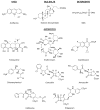Broad-specificity efflux pumps and their role in multidrug resistance of Gram-negative bacteria
- PMID: 21707670
- PMCID: PMC3546547
- DOI: 10.1111/j.1574-6976.2011.00290.x
Broad-specificity efflux pumps and their role in multidrug resistance of Gram-negative bacteria
Abstract
Antibiotic resistance mechanisms reported in Gram-negative bacteria are causing a worldwide health problem. The continuous dissemination of 'multidrug-resistant' (MDR) bacteria drastically reduces the efficacy of our antibiotic 'arsenal' and consequently increases the frequency of therapeutic failure. In MDR bacteria, the overexpression of efflux pumps that expel structurally unrelated drugs contributes to the reduced susceptibility by decreasing the intracellular concentration of antibiotics. During the last decade, several clinical data have indicated an increasing involvement of efflux pumps in the emergence and dissemination of resistant Gram-negative bacteria. It is necessary to clearly define the molecular, functional and genetic bases of the efflux pump in order to understand the translocation of antibiotic molecules through the efflux transporter. The recent investigation on the efflux pump AcrB at its structural and physiological levels, including the identification of drug affinity sites and kinetic parameters for various antibiotics, may pave the way towards the rational development of an improved new generation of antibacterial agents as well as efflux inhibitors in order to efficiently combat efflux-based resistance mechanisms.
© 2011 Federation of European Microbiological Societies. Published by Blackwell Publishing Ltd. All rights reserved.
Figures



References
-
- Aathithan S, French GL. Prevalence and role of efflux pump activity in ciprofloxacin resistance in clinical isolates of Klebsiella pneumoniae. Eur J Clin Microbiol Infect Dis. 2011 Feb 1; - PubMed
-
- Alekshun MN, Levy SB. Molecular mechanisms of antibacterial multidrug resistance. Cell. 2007;128:1037–1050. - PubMed
-
- Amábile-Cuevas CF, Arredondo-García JL, Cruz A, Rosas I. Fluoroquinolone resistance in clinical and environmental isolates of Escherichia coli in Mexico City. J Appl Microbiol. 2010;108(1):158–162. - PubMed
-
- Amaral L, Pagès JM, Fanning S. Efflux pumps of Gram-negative bacteria: genetic responses to stress and the modulation of their activity by pH, inhibitors and phenothaizines. Advances In Enzymology and Related Areas of Molecular Biology. 2011;77:61–108. - PubMed
Publication types
MeSH terms
Substances
Grants and funding
LinkOut - more resources
Full Text Sources
Other Literature Sources
Medical
Molecular Biology Databases

